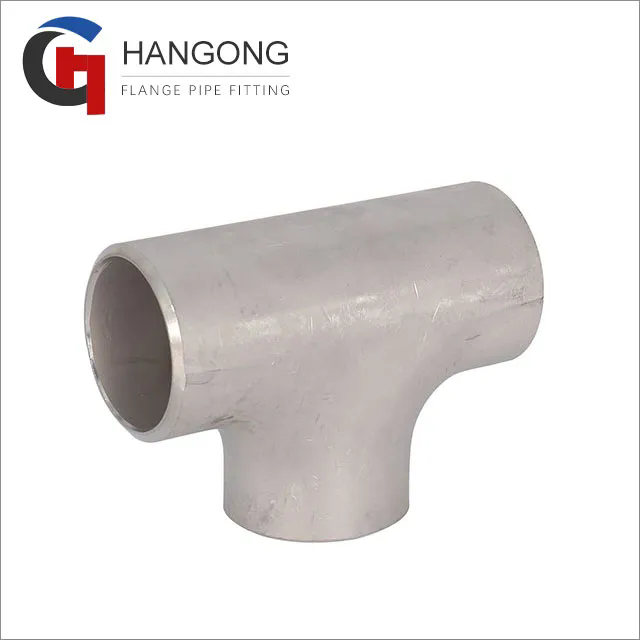Tee Pipe Fittings: Your Essential Guide
2024-10-22
Tee pipe fittings are essential components in plumbing and piping systems, allowing for the branching of pipes in various applications. In this FAQ-style blog, we’ll explore what tee pipe fittings are, their types, uses, and more, helping you understand their importance in piping systems.
1. What is a Tee Pipe Fitting?
A tee pipe fitting is a type of plumbing fitting that connects three sections of pipe. It is shaped like the letter "T," with one inlet and two outlets or vice versa. Tee fittings allow for the diversion of fluid flow within a piping system, making them crucial in plumbing, HVAC, and industrial applications.
2. What are the different types of Tee Pipe Fittings?
Tee pipe fittings come in several variations based on their design and application:
Equal Tee: All three openings are of the same diameter, allowing equal flow from each side.
Reducing Tee: One outlet is of a different diameter than the other two, enabling the connection of pipes of varying sizes.
Straight Tee: A standard tee that connects pipes in a straight line.
Side Outlet Tee: A tee with an outlet on the side, used for branching off a pipeline.
3. What materials are tee pipe fittings made from?
Tee pipe fittings can be made from various materials, depending on the application and requirements:
PVC (Polyvinyl Chloride): Lightweight, corrosion-resistant, and easy to install. Commonly used in residential plumbing.
CPVC (Chlorinated Polyvinyl Chloride): Suitable for hot water applications due to its higher temperature tolerance.
Metal (Steel, Copper, or Brass): Durable and strong, used in commercial and industrial piping systems.
Stainless Steel: Highly resistant to corrosion and suitable for sanitary applications.
ABS (Acrylonitrile Butadiene Styrene): Lightweight and impact-resistant, often used in drain, waste, and vent systems.
4. Where are tee pipe fittings commonly used?
Tee pipe fittings have a wide range of applications, including:
Residential Plumbing: Connecting water supply lines, drainage systems, and irrigation setups.
HVAC Systems: Distributing air in heating, ventilation, and air conditioning systems.
Industrial Applications: In chemical processing, oil and gas pipelines, and manufacturing facilities.
Fire Protection Systems: Used in fire sprinkler systems to branch off water supply lines.
5. How do I install a tee pipe fitting?
Installing a tee pipe fitting is a straightforward process, but it’s essential to follow these steps for a proper fit:
1. Gather Materials: Ensure you have the correct size and type of tee fitting, along with necessary tools (pipe cutter, wrench, adhesive, etc.).
2. Cut the Pipes: Measure and cut the pipes to the desired length using a pipe cutter.
3. Deburr the Edges: Smooth out any rough edges on the pipe ends to ensure a proper seal.
4. Apply Adhesive (if using PVC): Apply a solvent cement to the pipe ends and inside the tee fitting.
5. Insert the Pipe: Push the pipe ends into the tee fitting, ensuring they are fully seated.
6. Allow to Cure: If using adhesive, let it cure according to the manufacturer's instructions before testing the system for leaks.
For metal fittings, use a wrench to tighten the connections securely, ensuring no gaps remain.
6. Are there any safety precautions to consider?
Yes, safety is crucial when working with tee pipe fittings:
Wear Safety Gear: Always wear gloves and safety goggles when cutting or handling pipes and fittings.
Work in a Ventilated Area: If using solvent cement or other adhesives, ensure proper ventilation to avoid inhaling fumes.
Check for Leaks: After installation, check all connections for leaks before putting the system into operation.
7. What are the benefits of using tee pipe fittings?
Versatility: Tee fittings can be used in various applications, making them a staple in plumbing and piping systems.
Efficiency: They allow for the efficient flow of fluids in multiple directions, enhancing system performance.
Easy Installation: Most tee fittings are straightforward to install, even for DIY enthusiasts.
Durability: Depending on the material, tee fittings can withstand high pressure and temperature variations, ensuring longevity.
8. Can tee pipe fittings be used in high-pressure applications?
Yes, tee pipe fittings can be used in high-pressure applications, but it is essential to choose fittings made from materials designed to withstand the pressure levels involved. Stainless steel and certain types of PVC are often used in high-pressure scenarios. Always check the manufacturer's specifications for pressure ratings before installation.
9. How do I choose the right tee pipe fitting for my project?
To select the appropriate tee pipe fitting, consider the following factors:
1. Pipe Size: Ensure the fitting matches the diameter of the pipes you are working with.
2. Material: Choose a material compatible with the fluid being transported and the environment (e.g., PVC for water, metal for gas).
3. Pressure Rating: Ensure the fitting can handle the pressure of your application.
4. Application: Consider where the fitting will be used (residential plumbing, industrial settings, etc.) to select the best type.
10. Conclusion
Tee pipe fittings are vital components in plumbing and piping systems, offering flexibility and efficiency in fluid flow management. Understanding their types, materials, and applications will help you choose the right fitting for your needs, ensuring a successful installation and long-lasting performance. Whether you’re a DIY enthusiast or a professional plumber, tee fittings are indispensable tools in your piping toolkit.



